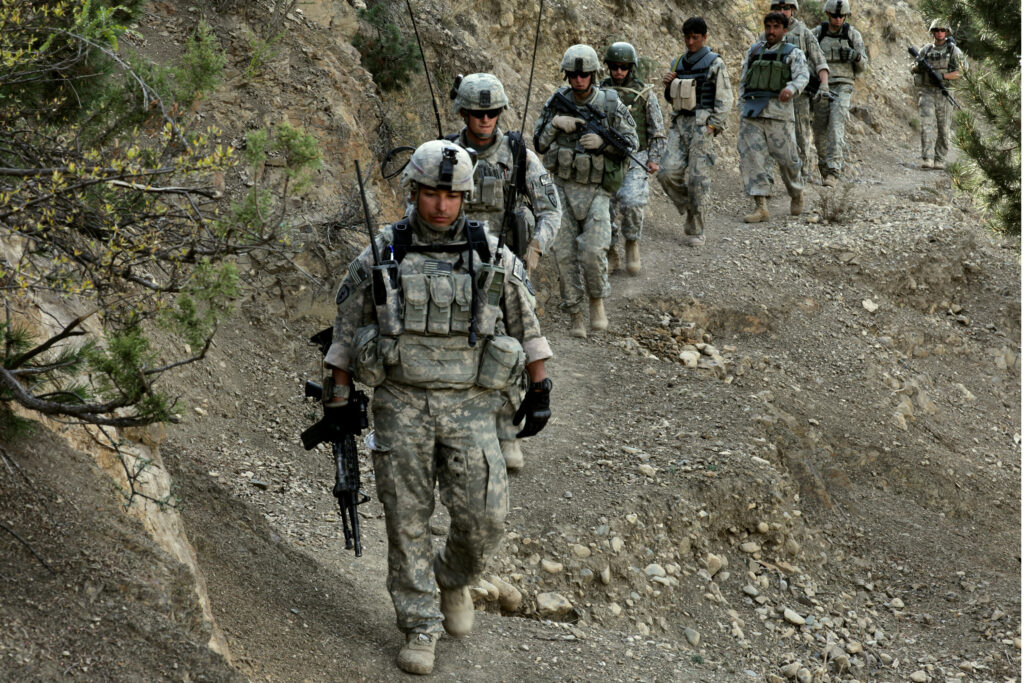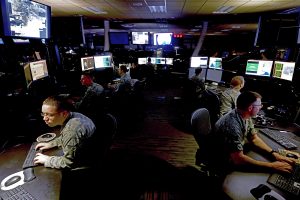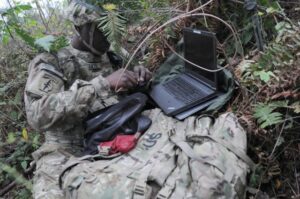
Army soldiers string out on patrol in the mountains of Afghanistan
WASHINGTON: The regular military is increasingly adopting artificial intelligence techniques pioneered by special operators, with a pilot AI project underway at the celebrated 18th Airborne Corps.

Prof. Richard Schultz
The same Algorithmic Warfare Cross Functional Team that developed Project Maven to track terrorists is now applying their technology to great-power conflict with advanced nation-states, said Richard Schultz, a professor at Tuft University’s Fletcher School who co-wrote a recent article on AI with SOCOM’s four-star commander, Gen. Richard Clarke.
“They’re broadening out to the peer competitor fight, and they have some very interesting initiatives with the 82nd Airborne Division, and the 18th Airborne [Corps],” Schultz said on a Hudson Institute webcast this afternoon. “The division wants to be the first AI-enabled division in the Army, and the corps, the first [AI-enabled] corps.”

Special Operations Command’s Gen. Richard Clarke with students at the Special Forces Qualification Course.
SOCOM was forced to adopt AI – and before that, databases and analytics – to handle the sheer volume of information it was collecting, from drone surveillance video to the outgoing call logs of captured cellphones to the biometric data so crucial to the surge in Iraq.
Analysts need to go through all those different kinds of data and combine them to identify terrorist ringleaders and send teams after them. It’s a feedback loop, a virtuous cycle, because each successful capture produces a new flood of data – phones, laptops, papers, bomb parts, interrogation transcripts – for the analysts to comb through to find more targets.
“To solve this problem of all of the information coming off the battlefield, [we had] to be able to increase our targeting cycle and to be able to do it more efficiently, without hundreds of people looking at all of the information,” Gen. Clarke said on the Hudson webcast. “You could apply this same targeting [approach] using artificial intelligence to help speed up the targeting process” across the entire military. In fact, that AI-accelerated cycle of gathering intelligence and acting on it is at the heart of the military’s vision for future All-Domain Operations.
AI isn’t just ingesting video feeds and target location, Clarke emphasizes, but all kinds of communications as well. Even the enemy’s propaganda is a clue to what they’re really up to and who they’re working with. “You want to be able to detect how [and] what an enemy is sending and receiving, what are false narratives, what are being sent across as bots,” he said. “Those allow decision makers to make faster decisions.”
 You see, when veteran operators like Clarke talk about “targeting,” they don’t just mean blowing stuff up with drones – though there’s plenty of that too. The best way to engage a target was to capture them, not kill them, and with as little collateral destruction as possible. That way you had living prisoners to interrogate, intact hard drives to comb through, and unharmed local civilians willing to work with you as informers rather coming after you for revenge.
You see, when veteran operators like Clarke talk about “targeting,” they don’t just mean blowing stuff up with drones – though there’s plenty of that too. The best way to engage a target was to capture them, not kill them, and with as little collateral destruction as possible. That way you had living prisoners to interrogate, intact hard drives to comb through, and unharmed local civilians willing to work with you as informers rather coming after you for revenge.
In many cases, Clarke said, it was as important to engage the neutrals, sending out well-crafted messages instead of smart bombs, so you could sway the population to support you and not the enemy. “In Afghanistan… from 2001 to 2018, our commanders on the ground, focused 70 percent of their time on the kinetic fight, of actually putting up putting a bomb on a target,” Clarke said. But the general recounted how a special ops commander now in Afghanistan told him that “I now spend over 70 percent of my time…delivering non-kinetic effects, because if we don’t come out with our messages, and we don’t influence the space, we will lose.”

Chinese artificial island in the South China Sea
Small Wars, Big Wars, Hybrid Wars
As the US pivots painfully from hunting guerrillas and terrorists in the Islamic world to deterring high-tech militaries like Russia and China, there’s growing disdain for the hard-won skills of counterinsurgency. How could lessons learned against Taliban thugs and ISIS butchers — men with AK-47s and homemade bombs and executioners’ swords for beheadings — be relevant to a 21st century conflict of long-range smart weapons?
Well,, it’s surprisingly relevant.
First of all, the Russians and the Chinese are not fools. They have no desire to make themselves targets for the precision-guided might of the US military, even as they build up their own arsenals, networks and sensors for long-range strike. Instead, remembering what the Communists taught them, Moscow and Beijing use subversion, propaganda, and proxies to achieve their goals “below the threshold of armed conflict,” without triggering an armed US response.
Sure, Russia’s Spetsnaz commandos are less brutal than the Taliban, and China’s “50-cent army” of social media trolls is more sophisticated than the Islamic State’s tweets of beheading videos. But the principles are much the same, which mean the countermeasures could be, too.

A soldier from the Army’s offensive cyber brigade during an exercise at Fort Lewis, Washington.
Second, even if the threshold is crossed to a full-scale shooting war, the rival armies won’t be lining up in empty fields to shoot it out. Instead, they’ll have to maneuver amidst the massive growth of global population, through megacities and urban sprawl, and in the face of ubiquitous surveillance technology, with civilians using everything from smart phones to hundred-dollar drones to share once-secret military movements. Guerrillas have long had to swim through Mao’s “sea of the people,” but increasingly the regular military does too, and you can detect it by its digital wake.
The traditional separations in US doctrine – between psychological operations, cyber warfare, and the real man’s business of blowing stuff up – no longer reflect reality, if they ever did.
“There isn’t really a separate ‘information operations’ world where it’s, you know, propaganda and disinformation and social media, and then you’ve got [distinctly] military data that’s targeting data on specific military systems,” said Bryan Clark, a Hudson Institute scholar. (He’s got no “e” in his name and is no relation to the general). “They’re all merged together in the information sources that are being employed by these algorithms, because [all] they allow you to better characterize a particular target.”
Even purely kinetic operations like airstrikes require extensive intelligence preparation, which includes requires figuring out what’s a real enemy target and what’s a civilian or neutral. You can’t just blast them all: Even if you didn’t have ethical limits, you’d run out of smart bombs before you ran out of potential targets.

Bryan Clark
“If you’re looking at peer competitors like this, let’s say the South China Sea, there’s a lot of [Chinese] maritime militia ships out there that could look like fishing ships,” Clark said on the Hudson webcast. “There’s [Chinese] Coast Guard, there’s actual [PLA] Navy ships, and there’re civilian ships that it’s unclear what their purpose is. And so you have to watch the pattern of life and get an understanding of what is their job on any particular day.”
This kind of AI-enabled intelligence just only helps tee up targets for wartime: It could help defuse a crisis and prevent a war as well. “What if you are not in World War III, but you have a gray zone altercation occurring?” Clark asked. “What’s the best way to defuse that with the lowest level of escalation possible?”
Much like SOCOM tracking terrorist ringleaders in Afghanistan, you’d want to sort through the Twitter bots, the online agitators, and the proxies to figure out who’s stirring up the trouble. Then you can try to shut them down – not with a missile, but maybe with a cyber attack to disable their social media, electronic warfare to jam their transmissions, or even a well-timed public statement to reveal a state-sponsored troll’s true identity to the world.
Consider a Chinese “fishing boat” that violates Vietnamese waters to create an international incident. Its transmissions, its point of origin and the personal contacts of its crew are all relevant data for the US commander trying to defuse the crisis, and AI can help pull all that together before it’s too late.
“Those are all pieces of information that a commander can use to decide, ‘what’s the best effect I can use to cause that guy to stop doing whatever he’s doing?’” Clark said, “and do it in a way that’s proportional, as opposed to hitting them with, you know, a cruise missile.”
“We are seeing that AI-enabled algorithms can ingest data from many different sources,” Clark told me in a follow-up email. “As long as the data is formatted in ways that it can understand” – which can be a big “if” indeed – “the AI’s inference engine will identify relationships and draw implications.”
“The automated integration of multiple open, unclassified sources could guide US operations on a scale and speed far beyond today’s capabilities,” Clark wrote. “It also leverages the rapidly growing amount of data available from commercial surveillance and consumer social and public media, which is vastly greater than the data available from government sources. Increasingly, these unclassified sources can support the bulk of intelligence needs, with government sources providing the niche capabilities.”
While the regular military is taking on this AI technology, Special Operations Command remains determined to play a leading role. “SOCOM can be a pathfinder for the Department of Defense,” Gen. Clarke said on the Hudson webcast. “SOCOM’s going to keep pushing.”
“We don’t have a choice,” he said. “If we don’t, we’ll get behind our adversaries.”
Airbus, UK agree $152 million deal for 6 H145 ‘overseas’ helicopters
The fleet of light-twin rotorcraft will replace Airbus Puma HC2 types, which have been temporarily based in Brunei for British Army training and the island of Cyprus in support of Royal Air Force search and rescue missions.


























